

Getting Started — MathJax 2.5 documentation. MathJax allows you to include mathematics in your web pages, either using LaTeX, MathML, or AsciiMath notation, and the mathematics will be processed using JavaScript to produce HTML, SVG or MathML equations for viewing in any modern browser.
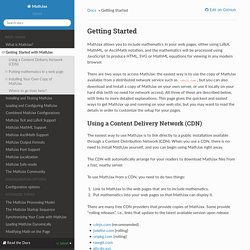
There are two ways to access MathJax: the easiest way is to use the copy of MathJax available from a distributed network service such as cdnjs.com, but you can also download and install a copy of MathJax on your own server, or use it locally on your hard disk (with no need for network access). All three of these are described below, with links to more detailed explanations. This page gives the quickest and easiest ways to get MathJax up and running on your web site, but you may want to read the details in order to customize the setup for your pages. Egg.js - A Simple Way to Add Easter Eggs to Your Site. Egg.js is a simple JS library that has no prerequisites and allows you to easily add web easter eggs by watching the user's key strokes.

Type the Konami code (up, up, down, down, left, right, left, right, b, a) to test it out. Example It's really easy to use. Just include the egg.js file on the page... Passwordless - Quick start guideline. The following should provide a quick-start on using Passwordless.
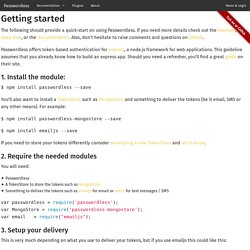
If you need more details check out the example, the deep dive, or the documentation. Also, don't hesitate to raise comments and questions on GitHub. Passwordless offers token-based authentication for express, a node.js framework for web applications. The Modern JavaScript Developer’s Toolbox. The Web Platform has gone a long way since HTML5 was first made popular and people started looking into JavaScript as a language that could do build complex apps.
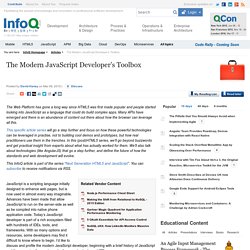
Many APIs have emerged and there is an abundance of content out there about how the browser can leverage all this. This specific article series will go a step further and focus on how these powerful technologies can be leveraged in practise, not to building cool demos and prototypes, but how real practitioners use them in the trenches. In this (post)HTML5 series, we'll go beyond buzzwords and get practical insight from experts about what has actually worked for them.
We'll also talk about technologies (like AngularJS) that go a step further, and define the future of how the standards and web development will evolve. This InfoQ article is part of the series “Next Generation HTML5 and JavaScript”. Chorus.JS. If you are new to Node.js and/or MongoDB there are many introductions you can look at.
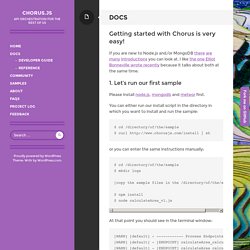
I like the one Elliot Bonneville wrote recently because it talks about both at the same time. D3.js - Data-Driven Documents. Gabelerner/canvg. CodeMirror. 14 Best WYSIWYG HTML Editors. In this post I suggest you to try 14 best free WYSIWYG editors that transform simple textarea HTML elements into powerful and useful rich text editors.
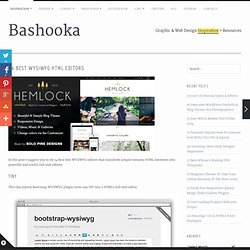
This tiny jQuery Bootstrap WYSIWYG plugin turns any DIV into a HTML5 rich text editor. Documentation. JSHint is a program that flags suspicious usage in programs written in JavaScript.
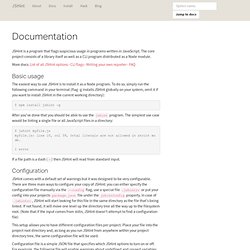
The core project consists of a library itself as well as a CLI program distributed as a Node module. More docs: List of all JSHint options · CLI flags · Writing your own reporter · FAQ Basic usage The easiest way to use JSHint is to install it as a Node program. To do so, simply run the following command in your terminal (flag -g installs JSHint globally on your system, omit it if you want to install JSHint in the current working directory): Mode hors ligne avec LocalForage. La Fondation Mozilla a sorti localForage, une nouvelle bibliothèque JavaScript qui permet de simplifier le processus de stockage hors ligne de données dans des applications web.

Bien que ce ne soit pas une technologie récente, le support de mode hors ligne a toujours été trop fragmenté à cause du trop grand nombre de choix disponibles. Ce qui rend cette librairie unique est qu'elle essaye de combiner le meilleur de chaque monde : les fonctionnalités issues des technologies les plus récentes (asynchrone et support des blobs) avec une API simpliste. Ceci permet de proposer des modes hors ligne puissants aux applications web, les rendant plus proches des applications mobiles et plus intuitives pour les développeurs.
Un des premiers choix disponibles était localStorage qui fournit une méthode simple pour accéder à du stockage hors ligne. Cependant, les tests ont montré qu'il était lent, synchrone et ne supportait pas les blobs (par exemple, pas de cache de fichier mp3 possible). Trending JavaScript repositories on GitHub today. PeerSquared – one-on-one online teaching with WebRTC. It was somewhere in the midst of 2010 when I first learned that the people at Ericson Labs were working on an ‘open standards’ browser implementation for P2P video chat.

I was excited right away. The fact that you could only use video chat in your web browser through Flash or other plug-ins bothered me. Webcams had already been around for quite a few years, but their use was mainly limited to proprietary programs like MSN Messenger and Skype. We’re now three years later and it is all going to change. Just a couple of days ago P2P video chat made it to the Final Release of Firefox 22. PeerSquared After reading about Google Chrome and Firefox adding data channels to P2P connections I was getting even happier, since it offers loads of new possibilities. The current version is a proof of concept, to see for myself what is really possible with the PeerConnection API and data channels in particular. Create useful relevant JavaScript documentation with JSDoc. This blog post is also available as a TechRepublic PDF download.
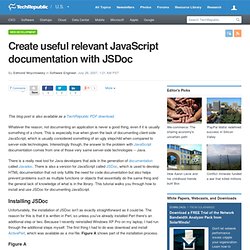
Whatever the reason, not documenting an application is never a good thing, even if it is usually something of a chore. This is especially true when given the task of documenting client-side JavaScript, which is usually considered something of an ugly stepchild when compared to server-side technologies. Interestingly though, the answer to the problem with JavaScript documentation comes from one of those very same server-side technologies -- Java. WebFont Loader - Google Fonts. Hammer.js - A javascript library for multi-touch gestures. Raphaël—JavaScript Library. Processing.js. Lipka/piecon.